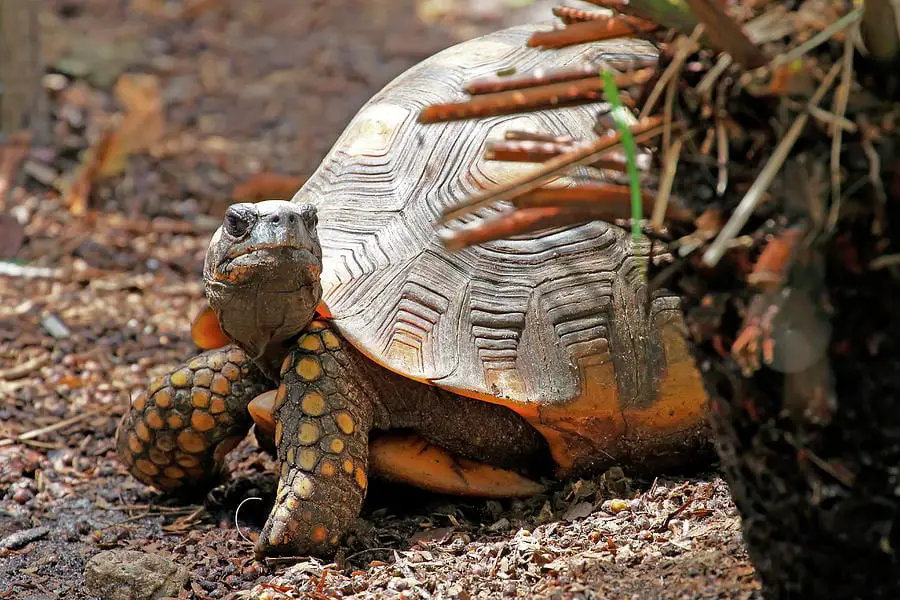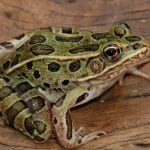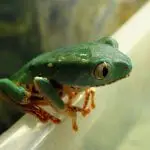Scientific Facts
| Common Name | Yellow-footed Tortoise |
| Scientific Names | Chelonoidis denticulatus |
| Origin | Southern Colombia, Brazil, Guyana, French Guiana, Ecuador, Bolivia, and Brazil |
| Habitat | around bodies of water and in some bushy areas in the tropical forests |
| Diet | plants, grasses, mushrooms, fallen fruits, slow-moving invertebrates such as worms and snails |
| Size and weight | Adult size: 24-28; 25 pounds |
| Life Span | 50-60 years |
Physical Characteristics
The yellow-footed tortoise or also known as the Brazilian giant turtle, is considered as the 6th largest tortoise species. They are characterized to have a long oval high domed back with a flat vertebral. They have a total of five vertebral scutes with eleven pairs of marginals, four pairs of coastal, and one large supracaudal on their tails. The carapace is colored brown to dark brown with edges of color black scutes.
The areola part has orange, pale yellow, and light brown carapace. The plastron or the shell at the bottom part has thick edges with yellow-brown seams. They have a long and small head with upper jaws that are equipped with three tooth-like points that match their big eyes. Their hind-limbs has four claws that resemble the limbs like that of an elephant that is covered with small scales.
The males and females slightly differ in the size of the males being larger. The males tend to have a distinctive incurving of sides that give them a well-defined waist. When it comes to their tails, females have a conical short tail while the males have a long muscular tail that is usually tucked along its side
Where they are Seen?
Yellow-footed tortoises are found in the humid rainforest areas of southern Colombia, Brazil, Guyana, French Guiana, Ecuador, Bolivia, and Brazil.
Habitat
There are some discussions as to where these yellow-footed tortoises live in the wild. Some say they prefer the grasslands and dry forest, while some say that their habitat is in the rainforest that has a humid atmosphere. Whether they live in a dry or wet area, they spend most of their days around bodies of water and in some bushy areas in the tropical forests.
Behavior and Temperament
The yellow-footed tortoise produces sounds like that of a baby cooing with a hoarse voice. These tortoises are identified by how they do bodily movements. Males do head movements, especially during the mating season, while females standstill. When they are threatened, they’ll just hide in their shell since they cannot escape because they move slowly.
Diet
The yellow-footed tortoise eats different kinds of foliage from different kinds of plants since they have difficulty in capturing fast animals or insects because they are slow-paced creatures. Their diet consists of plants, grasses, mushrooms, fallen fruits, slow-moving invertebrates such as worms and snails. In captivity, they are always given shredded carrots, oranges, apples, insects, worms, edible flowers, cuttlebone, and vitamins.
Size and Weight
The yellow-footed tortoise is considered as the largest tortoise in South America. There are those who grow about 13 inches long, but there were recorded tortoise that has a size of 24-28 inches. An average-sized yellow-footed turtle weighs 25 pounds.
Breeding and Reproduction
The breeding and reproduction season starts at the onset of the rainy season, which is usually from July to September. The males are identified through the movements of their heads with a series of quick sudden movements from their back. If there is no movement, it means that that is a female. It takes 8-10 years for the females to be sexually mature. The bigger their body is, the more productive they are in producing eggs. Copulation follows when the makes sniff the cloacal region of the females. During the whole process, the males tend to create a guttural sound like that of a hen.
A healthy pair of yellow-footed tortoise have a clutch of about 6 to 12 eggs in a particular season and is dependent on the size of the females. The eggs are not calcified; that is why its shells are brittle with a diameter of 3-6 cm that is elongated in shape. These eggs will be laid 6 weeks after. When the eggs are in an environment with at least 85 degrees Fahrenheit, it will hatch in 100-150 days.
Common Disease/ Illnesses
Minor ailments can include minor cuts and abrasions, long toenails that are chipped, cracked, or broken beak
If you see a cut, you need to immediately wash the area with lukewarm water and soap. You can apply an ointment or topical antibiotic, but as soon as you notice swelling, it means that it needs further medical assistance. Make sure that when your tortoise has wounds, it is staying in a clean substrate to avoid infections.
Respiratory Infections
This is commonly caused by lower temperatures, bacterial infections, and stresses that lower their immunity. When you hear a wheezing sound with a mucous discharge from the mouth or nose, it is most likely that they are suffering from respiratory infections. It is fatal, especially when the nasal passages that allow them to breathe is clogged. Separate your tortoise from the other because it is contagious.
Shell Rot
This is commonly caused by a fungus or bacterial infection. Any cuts, abrasions, lesions, or scrape is where bacteria can enter. If these bacteria are not treated, it may lead to shell rot that causes septicemia, which is an infection to the bloodstream. Shell rot is characterized as having white powdery, flaking patches on the skin. Medical assistance is needed to give first aid.
Swollen Eyes
If your tortoise has a vitamin A deficiency, bacterial infection, and improper diet, it is evident in the eyes of the turtle. You need to take it to your veterinarian for the proper dosage of antibiotics.
Parasite infestations
Internal and external parasites can infect your pet, and it is usually due to poor husbandry. There are certain medications for a specific kind of parasite; that is why you need to seek medical assistance.
Calcium Deficiency and Metabolic Bone Disease (MBD):
Problems in the shell and bones are common to the tortoise, and this is due to calcium deficiency. Supplements and nutrients that are mixed in with their meals will help them alleviate these diseases.
Preventing Disease/Illnesses
There are a lot of factors why yellow-footed tortoise gets sick; the number one factor is when they live in a poor and unsanitary environment where different bacteria that affect their immunity thrives in. Nutrient deficiency is another factor because if a certain nutrient is missing, it might cause detrimental effects on the development of your pet. Ss soon as you see that your pet is sick, determine the possible effect and range of severity to know if you need to go to your veterinarian.
Availability-Where to Get One?
Yellow-footed tortoise is now endangered; that is why it is illegal to take them out in captivity. It is impossible to see this tortoise in a local pet shop, but there are quite a good number of people or collectors who are keeping it in captive and breeding their own for selling. You can find them on the internet. However, if they live outside your country, both of you might be in trouble since this is now an endangered species, so better find a pet collector within your area, so it is more convenient.
Captive Breeding
Yellow-footed tortoise is interesting to keep and breed. Owners who have this in captivity are encouraged to breed so as to increase their population even in captivity because they are now considered as endangered. Petting these tortoises is quite a challenge because they do not like to be handled more often. They can live long in captivity as long as they are given the ideal environment.
How To Care Reptile as a Pet
Housing
Yellow-footed tortoise needs to stay in a shaded environment with a stable temperature. You can let them stay in a medium-sized tank or in a large tub. Hatchlings need to have at least 2ft x 3ft enclosure while adults need at least 8ft x 4ft enclosure. Adults usually have an area of 8ft by 4ft.
You can also house them outdoors provided that it is in the warmer months and make sure that their placing is secure with a predator-proof. The pen walls should be at least 15 inches high. Different non-toxic plants will serve as their shaded area so as to protect them from the harsh rays of the sun still.
Lights and Temperature
Yellow-footed tortoise needs to have light exposure to keep them healthy and to ensure that they get the right amount of Vitamin D synthesis. The artificial lighting is in the form of a lamp that provides at least 85 to 90 degrees Fahrenheit with a full-spectrum UVB lamp. There should be two areas in their tank; one is for basking where the lamp is situated is one area that has a normal temperature that is a bit dim since tortoise appreciates the dark and quiet area.
Substrate and Accessories
The choice of a substrate is important because it can normalize the moisture level, and it keeps the humidity at the right level. A good substrate is a long-fibered sphagnum moss mixed with organic topsoil, peat moss, sand, or an untreated mulch. Their tank should also be equipped with water areas where they can easily access and soak. The level of the water basin should at least be 1 inch deep for juveniles and at least 3 inches deep for adults.
Diet
They are considered as an omnivore where their diet consists of insects, plants, and small animals. They are usually given fruits, green leafy vegetables. They are given supplements that are offered at least once a week. Juveniles are given food every day with a sprinkle of supplements, specifically calcium, that is an aid in their growth.
Every day or every other day feed adult captive tortoises a mixture of high-calcium greens (collard, mustard, and dandelion), vegetables and fruits (pumpkin, winter squash, grated carrots, crookneck squash, zucchini, papaya, mango, kiwi, melon, cantaloupe, and prickly pears), and flowers (hibiscus, nasturtium, prickly pear flowers, and dandelions). Other acceptable greens, such as endive, watercress, romaine, kale, and escarole, can be mixed in for variety.
Handling
Generally, tortoises are shy; that is why they do not like frequent handling. You know that they are uncomfortable if they will just hide in their shells. If they started to be captive bred in the wild since their juvenile years, there is a possibility that their behavior and temperament would be more socially inclined.
Breeding
Placing one male and female in a tank would definitely lead to breeding and mating as long as their tank is kept warm. Females should be given calcium and protein in their diet.
Conservation status
Yellow-footed turtle is now considered an endangered species. There many reasons why they are nearly extinct because of the loose if their habitat, illegal hunting, and instead of captive breeding, they end up as delicacies in the market, especially for some cultures. There are now captive groups that help breed these tortoises to increase their population.
FAQ Section
Do tortoises love their owners?
They are considered an affectionate species, and they have the ability to recognize their owners. They feel if they are being loved when they are rubbed or scratch gently through their shells that have nerve endings.
Do tortoises like being touched?
They like being touched when they feel security and love through gentle rubs from their shells through their necks.
Do tortoises get lonely?
Yellow-footed tortoise is solitary reptiles that don’t get lonely. They are used to living alone. In captivity, they can only be housed a maximum of three tortoises.
Do tortoises stink?
A yellow-footed tortoise doesn’t smell like your dogs and cats, they don’t smell bad, but they also have a smell that is an indication that you need to bathe them or clean their tanks.
Can yellow-footed tortoises hear you?
They don’t have an excellent sense of hearing. They tend to process things through sound frequencies. The way how they sense vibrations are accurate. They also have a good sense of smell and sight.
Do yellow-footed tortoises bond with humans?
They have the ability to bond with their owners, but the way how they show affection is not just like your dogs and cats.
How do you know if a yellow-footed tortoise is happy?
You can tell that a tortoise is happy through their shell’s shape and condition. You can tell if they are healthy through the appearance of their shells.
Should yellow-footed tortoise be kept alone?
Most tortoises live alone, which is not crucial to them, but you can stay a couple of turtles in one tank; just be sure not to mix tortoise that has a different size. You can let two females and one male stay together, but not all males because they tend to be aggressive.
What color is yellow-footed Tortoise poop?
The most tortoise that is healthy tends to have feces that are brown to greenish-brown, but it would depend on their ingesting.
What happens if a tortoise gets too cold?
When there is a drastic change in the temperature, expect that your yellow-footed tortoise will be prone to respiratory infections.
How often should I bathe your yellow-footed tortoise?
For juveniles, they should bathe daily. But for adults, you can bathe then at least once a week.
Do yellow-footed tortoises bite?
There are times when they unintentionally bite, especially when they are threatened. Their bites can be painful and can draw blood because if the wound even though they do not have teeth.
Do tortoises like rain?
They are naturally from the tropical rainforests, that is why they somehow get used to the rain. The rain serves as a way for them to rehydrate.
How do you rehydrate a tortoise?
In captivity, you can rehydrate your tortoise by means of soaking them in a tub with water.
How do I know if my yellow-footed tortoise is dying?
When your tortoise is dying, their head and four legs are outside the shell, and they feel limp to touch. Their eyes can be sunken. Check for the signs because there is a possibility that they ate just dehydrated.



